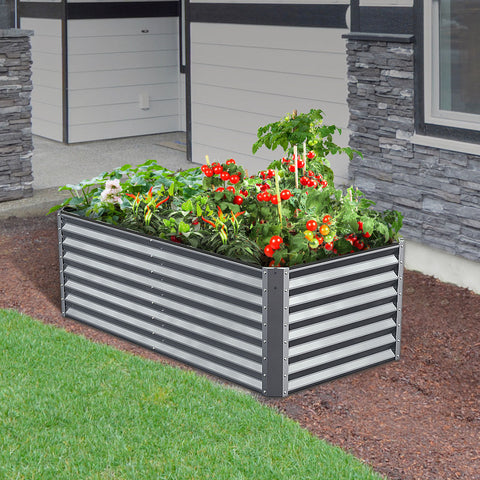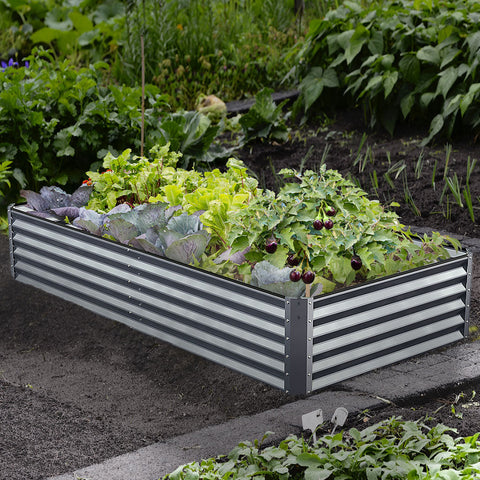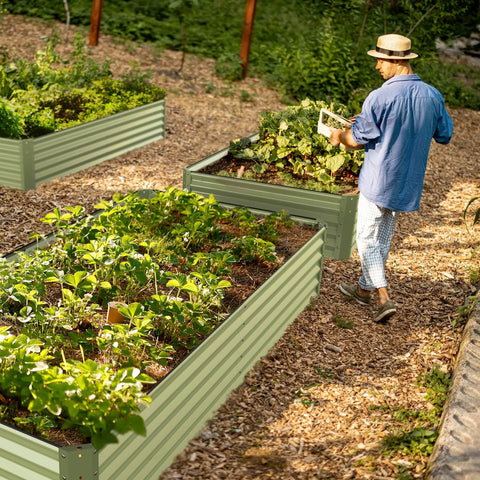Due to complex factors such as weather, soil, and pests, this may be a difficult question for beginners to answer. This article will help solve this problem and provide gardeners with simple tips on planting lettuce from seeds at all levels of experience.The following content also has some reference value for raised garden beds.
Tip 1: Choose these 4 types of lettuce Although you can grow hundreds of types of lettuce, I recommend 4 options to choose from. When trying to learn how to grow lettuce with seeds, these are the simplest types.
A) Loose leaf lettuce Looseleaf lettuce is considered the most popular type of lettuce in North America, with colors ranging from purple to green. This type of lettuce is called pine leaved lettuce because it does not form a head and has many varieties. This type of lettuce takes about 45 days to mature, but you should start thinning and harvesting within 3 weeks to promote future plant growth. As lettuce grows, you should harvest the leaves from the outside to the inside, starting with the lowest leaf.
B) Buttered Lettuce Butter head lettuce is another very popular type of lettuce in North America, so named because it forms a soft, loose head. Although this plant grows smaller than other types of lettuce, it has a tender and delicious taste. Depending on where you live, this type of lettuce can be harvested anywhere from 30 to 70 days. Moreover, it often performs better in colder temperatures, and if the weather becomes too hot, it may even become bitter. C) Romance lettuce Roman lettuce is often grown directly from the ground and is one of the most popular types of lettuce in restaurants. Roman lettuce is famous for its crispness, crispness and dark green.Roman lettuce takes about 60 to 70 days to mature, and when the central leaves grow together to form a long head, you know when to harvest Roman lettuce. Although this type of lettuce can be sown like other lettuce, it is also the most heat-resistant and can be planted in spring and autumn.
D) Iceberg lettuce Iceberg lettuce is one of the most delicious types you can grow, but it is also the most difficult to grow, taking 80 days to mature. Although this type of lettuce has much lower heat resistance than other types of lettuce, its storage and transportation are indeed much better. When iceberg lettuce forms a head like the one in the picture, you will know when to harvest it. Due to the difficulty of planting, it is also the most expensive lettuce sold in restaurants. Tip # 2: Start the seed indoors Due to its ability to withstand low temperatures, planting lettuce with seeds can be done indoors and outdoors. Please read the following content to learn how to plant lettuce with seeds indoors and outdoors. Step 1- Start sowing 6 weeks before the last frost Before you plan to move the lettuce into the garden or move the planter outside, you need to start sowing within approximately 6 weeks. You need to take a 3-inch pea jar and fill it with approximately 80% Miracle Gro Potting Mix. Spray the soil five to eight times with a spray bottle. You would want the soil to be moist, not moist. Moist soil can cause unwanted fungi.
Step 2- Gently sprinkle 4-5 seeds per pot Due to the small size of lettuce seeds, it is sometimes necessary to grab one or two seeds to plant them. On the contrary, sprinkle 4-5 seeds approximately 1/8 inch deep in each pot, then gently brush the soil onto the seeds. Then spray the soil again 5 to 8 times until it turns dark.
Step 3- Provide your seeds with at least 8 hours of sunlight After sowing, if the windows do not have enough sunlight, place the flowerpot next to the window or growth lamp to provide at least 8 hours of sunlight. You also need to maintain the room temperature between 50-65 degrees Fahrenheit. Nevertheless, you can even plant lettuce seeds at temperatures as low as 40 degrees Fahrenheit. If you don't have an area that can sustain around 50-65 degrees, I suggest investing in a plant heating pad. A plant heating pad is the perfect way to keep the temperature of the flowerpot and seeds consistent, otherwise we may not be able to do so.
Step 4- Spray, Spray, Spray After the initial planting, you need to spray the soil once or twice a day for approximately 10 days. Your seeds will take approximately 10 days to germinate or germinate in the soil. Once your seeds sprout and sprout in the soil, you will want to continue spraying twice a day for 4 months until they are ready to be transplanted outdoors.
Step 5- Trim and transplant the lettuce plant into a larger pot Once your lettuce has grown for about 3-4 weeks, you can start thinning it, allowing only one plant to grow, or you can put all the plants in a pot. If you keep all the plants, they may not grow as plump as a lettuce. You can use scissors to cut smaller plants on the soil line. This will enable healthier lettuce to fully realize its potential. Next, you can transplant your lettuce to a 5-gallon nursery. Similarly, you may want to fill these jars with approximately 80% of your potted plant mixture. Next, you need to make a hole about 3 inches deep (about the size of your lettuce). Then invert your existing small pot, pinch its bottom, and gently pull out the soil and your plants. Then you put it in a 5-gallon jar and fill it with soil. After you do this, immediately spray the soil approximately 5 to 10 times. Then you will want to leave your lettuce in this pot until it is ready to be transplanted outside. Step 6- Introduce your lettuce to the outdoor weather The next step is something that most beginners miss, but it is crucial for your success. In about two weeks, you will want to gradually introduce your lettuce to the outside world. On the first day, you will want to leave the lettuce outside in direct sunlight for about 2 hours. Every day thereafter, leave the lettuce outdoors for an additional hour until you continue for 6 hours.
Tip 3: Transplant lettuce outdoors Once the last frost of the year occurs, you can transplant lettuce outdoors. If you transplant lettuce before the last frost, it may die. To prevent this from happening, I suggest planting it on a raised garden bed. This can transplant your lettuce into your garden! About a month before you plan to transplant lettuce into the garden, dig a hole about 8 inches deep and fill it with compost. Space the holes 12 to 18 inches apart. Dig a hole in a place with partial shadows. Then, after the last frost, transplant the lettuce into the garden, just like transplanting it into a larger flowerpot. Finally, water the lettuce once a day. Continue doing this until you harvest the lettuce in midsummer.
Tip 4: Planting lettuce seeds in the garden No matter where you live, lettuce is one of the easiest vegetables to grow outdoors. Whether you are unable to sow indoors or just want to sow directly in the garden, I suggest you follow the following instructions:
Step 1: Start sowing after the last frost You should start sowing lettuce seeds after the last frost. Lettuce seeds germinate best at temperatures ranging from 50 to 65 degrees Fahrenheit. Nevertheless, they can even grow in temperatures as low as 40 degrees Celsius!
Step 2: Sow in this way! Once you decide to start sowing outside, you will want to take the following simple steps: find a cool and shady place with a pH value between 6.0 and 7.0. Dig a 1/8-inch hole with your fingertips or pencil. Maintain the hole at a distance of approximately 2 feet so that the maximum amount of lettuce can grow. Gently sprinkle 4-5 lettuce seeds in each area. It should be noted that not all seeds will sprout, and you can thin them after the plant grows. Gently cover your seeds and spray 8-10 times until the soil turns dark brown.
Step 3: Continue watering your seeds After you first planted lettuce seeds, you would want to water them 2-3 times a day until the soil turns dark brown. You need to do this until the seeds germinate, and then continue to do so until they become at least 3 inches tall. If the weather in your garden is hotter than usual, you may need to water it several times a day, as mentioned above.
Tip 5: Use this method to effectively care for your lettuce!
Here are the nursing tips for lettuce throughout the summer:
Keep soil health - Before planting and throughout the summer, quickly check the soil for fungi, harmful insects and weeds. Remove and replace with new soil as needed. Water the soil instead of watering the plants. By watering the leaves, there is an increased risk of fungal and other disease transmission. Don't drink too much water as it increases the likelihood of getting sick. Remove diseased and dead plants. This is the simplest way to prevent the spread of deadly diseases. If you notice yellow spots on the leaves, it means you may have fungal wilt and want to remove the leaves. Plant your lettuce in a new place every year. This is the key to preventing seasonal diseases and insects from attacking the same plant year after year. Prevent insects. The best way to prevent them is to use insecticides. If you don't want aphids, slugs, or cabbage worms to disrupt all your hard work, I suggest you purchase garden safety pesticides
Tip 6: Use this method to effectively harvest lettuce! Harvest lettuce 3 to 10 weeks after planting. Harvest lettuce frequently. This will help to make it thinner, ensure the best possible flavor, and help prevent sowing. Always pick lettuce where it touches the stem. Pick your lettuce from outside to inside.









